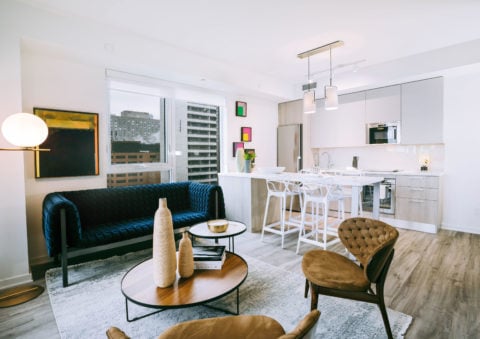Yes, It’s Possible to Be Design-Savvy in Small Rental Spaces
"How you use your space, no matter its size, is a reflection of your personality," says internationally renowned interior designer Johnson Chou.
Recently, I was sucked into the Design Home vortex. In the rare case that you haven’t yet come across the wildly popular mobile game, allow me to briefly explain: Essentially, it’s the part of The Sims where you furnish a lavish suburban mansion. The game has been downloaded over 50 million times, generated $157.7 million via in-app purchases in a single year and has effectively turned me into an interior design enthusiast/addict/snob. But here’s the thing: as a 20-something living in a cosmopolitan city, I likely won’t be furnishing a ‘Grand Denver Cabin’ or ‘Minneapolis Menagerie’ anytime soon. For me, Design Home has filled the gap that exists between social media influence and a housing bubble, wherein millennials are presented with excessive displays of wealth and design inspiration on Instagram but might live in cookie-cutter condos for their entire lives.
There are, however, examples of design-savvy living that exist outside the virtual universe on my phone screen, and within my rent-only budget. Developers, architects and interior designers are refining rental living, giving thought and inspiration to the pint-sized and box-like units available for rent in downtown highrises. The Selby, a purpose-built rental in Toronto’s South Rosedale, is an example of where this design-focused rental living is headed. Your space might be small, your wall colour might be white and you might put yourself at risk of losing your damage deposit if you start nailing in shelves, but there are ways to personalize your rental property and make it feel like home.
Internationally renowned interior designer Johnson Chou, who was brought on by Tricon House to design The Selby’s interior, says that “how you use your space, no matter its size, is a reflection of your personality. Whether it’s a piece of sculpture, a painting or just a book on a coffee table, it inevitably is a reflection of your hopes, your dreams, your interests and who you are as a person.” When you see home design being put in these weighty terms, you might start to reconsider your six-year-old IKEA sheepskin rug and free posters held up by sticky tack. Chou promises that curating a tastefully designed rental space is simple: just keep things low, add some light and treat your possessions like art pieces. Find his top tips below.

Tip 1: Keep it Low
“The first thing you have to do is think about the space itself,” says Chou. In a small rental condo, for example, you’ll want to keep furniture low because the ceilings aren’t high and what you don’t want to have is too many things that obstruct your view; things that in the end create sort of visual clutter. “You need to make sure there aren’t too many pieces that are visually battling each other. You want to have a sense of hierarchy in the space.”

Tip 2: Curate Your Possessions
Chou wants you to think of your possessions as art pieces. “It’s not that you should make them too precious,” he clarifies, “but you should be thinking about the space around each piece. Think about how the colours of a book cover might relate to the vase next to it.” He suggests rotating select items in and out of your space, keeping things fresh by showcasing what’s meaningful to you at the moment. “When you want a change,” Chou says, “go into your storage space and pull something else out that means something to you at that time.”
He explains that what you don’t want to do is to create conflicting colours or forms, “because what happens is that something that’s perfectly beautiful gets demeaned, whether it was intentional or not, and then suddenly it looks like junk.”

Tip 3: Bring in Light
In most rental apartments, lighting is limited. Your windows might be small, the sun could be clocked by other highrises and concrete ceilings prevent you from drilling in a fancy chandelier. Chou suggests adding floor lamps to small spaces by positioning them in corners or behind furniture. “Lighting significantly changes the character of the room and helps to amplify details of the space,” he says. “If there’s something special you want to highlight—like an interesting chair or a painting—give it some extra light. You’ll create hierarchy in the room, and in doing so, make it feel larger.”








